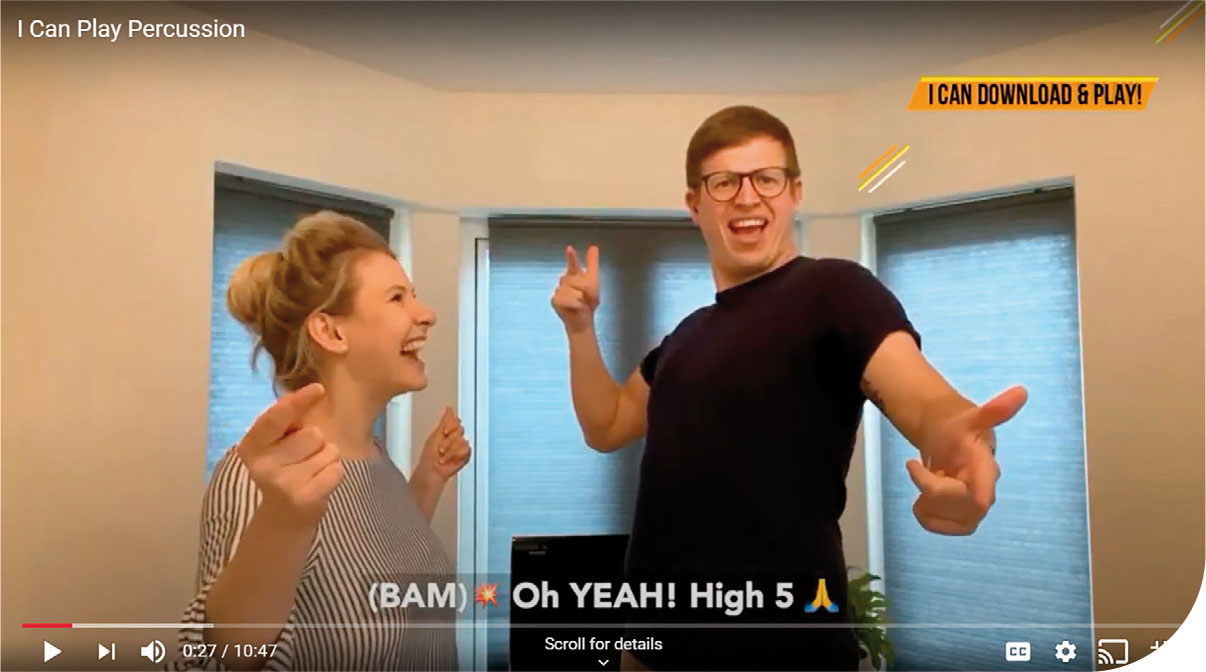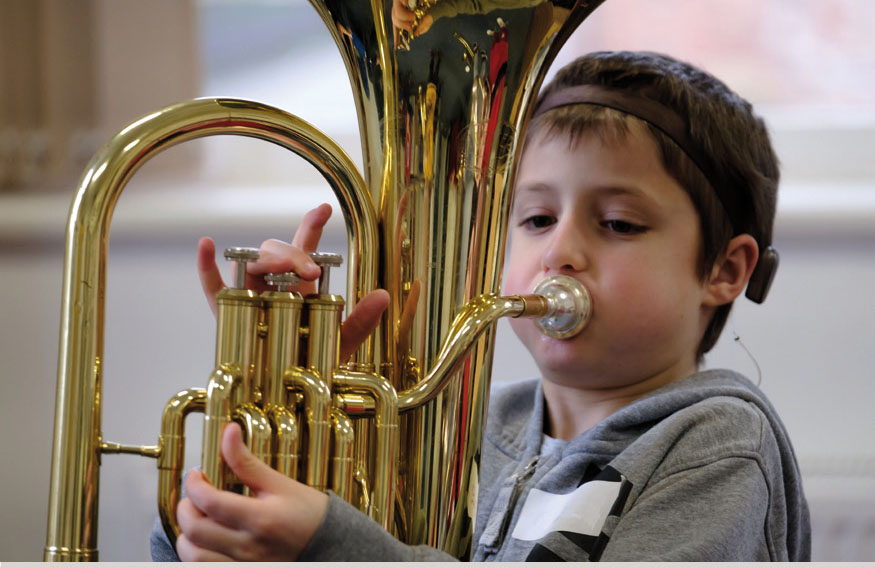
Music and the Deaf (MatD) is a UK charity entirely dedicated to providing access, education, and opportunities in music for D/deaf young people and adults. Presented in partnership with the National Centre for Early Music (NCEM), the team's I Can Play! project has been enriching the lives of children with hearing loss through music-focused opportunities. Like much outreach work in music education, the pandemic hasn't pressed pause on the project's offerings, as I Can Download & Play! provides free videos and online resources for young people across the world. In June, the team also launched the first I Can Play! Inspiration Day, livestreamed for primary school-aged D/deaf children.
To gain insight into their work, I spoke to composer, musician, and artistic director of MatD, Danny Lane, who is profoundly deaf, and professional deaf trumpeter and music teacher Sean Chandler about their experiences in music education. NCEM's director Delma Tomlin, participation and learning manager Lottie Brook, and a BSL (British Sign Language) interpreter also joined us.
Why now?
‘I did have supportive teachers growing up,’ Lane says, ‘but when I wanted to get more serious about music, I was looking for a local college. Teachers there were saying, “Sorry, I don't know what we can do for you because you are deaf – how can that work? It's impossible”.’ These misconceptions and the subsequent discrimination towards young D/deaf musicians are not uncommon, and they are something that Lane and the I Can Play! team are trying to remedy.

Sean Chandler and Jenni Cohen in a video for I Can Download and Play!
Throughout the pandemic, both MatD and NCEM spotted that the transition of mainstream music education to a virtual space presented another challenge for D/deaf children. ‘It is difficult to engage D/deaf children with music anyway due to a lot of misconceptions about how they can enjoy it and benefit from it’, Brook says, ‘and then you add the virtual element too.’ Committed to giving young D/deaf musicians a platform and resource during lockdowns, the team created I Can Download & Play!. Despite this being a steep learning curve for all involved, the resource managed to reach more families through digital learning than the project did before, from all over the world. ‘I think everybody should have the opportunity to make music, and how we facilitate that is the key,’ says Tomlin.
Lane emphasises the importance of the project, saying, ‘Being D/deaf is already very isolating. It is very hard to integrate and communicate across barriers. I think with the pandemic, it makes it worse and more isolating, and it can affect your mental health and self-esteem. It is very important to reach out to D/deaf children as much as we can, and I think this digital resource is a wonderful thing. The community is very dispersed, so now we can reach people in their own homes without any geographical barriers.’
Child-centric
Chandler has been one of the hosts in the I Can Download & Play! series, producing engaging videos for students at home. He is a perfect fit for the role, transitioning between comedic jibes and intellectual remarks with ease. ‘I think that there is a real issue of D/deaf children being excluded from music, and in the workshops the D/deaf children have been placed at the centre.’ Chandler says. ‘Usually, workshops are led by mainstream practitioners and then someone provides an interpreter, whereas this was created with the D/deaf children in mind.’
Lane makes clear that every D/deaf child is different and has had different experiences with music. ‘Some will have partial hearing, because we are not just talking about being deaf, as in not being able to hear at all.’ Lane explains. ‘So, where we have different levels of hearing loss, we need to be aware that they will have different levels of exposure to music. Some will have been taught music, some will have had no lessons whatsoever and will have been removed from the classes. So, we have to be flexible with how we approach D/deaf children, and I always say that we must keep an open mind.’ Lane's overriding advice is to keep sessions as practical as possible, so that D/deaf children can access activities through their individual ways such as through visual means, BSL, or playing sounds.
Mind the gap
As the discussion moves onto the current holes in music education, Chandler springs into action: ‘There are really gaping inequalities across the education system in terms of musical provision. I think for me there isn't enough funding given to D/deaf children.’
Chandler believes that the access requirements for D/deaf students taking GCSE and A Level exams have not been fully considered. He says, ‘We are still having listening exams for D/deaf children who can't access sound. I think assessment procedures need to be looked at from a D/deaf person's point of view if we are going to make music accessible for D/deaf children. It reminds me of that quote from Albert Einstein: “Everyone is a genius. But if you judge a fish on its ability to climb a tree, it will live its whole life believing that it is stupid”. Unless we think differently about how we assess D/deaf children's music ability, then we are going to be stuck.’
Funding for after school and extracurricular activities for D/deaf children is another important topic for Chandler, as he explains that funding for communication support workers and teachers of the D/deaf only extends to within the school day, limiting D/deaf students from engaging with extracurricular activities – often music. ‘Usually, communication support workers through their own good nature will stay and sign everything and make sure there is access for the D/deaf children, but there is nowhere near as much funding as there should be,’ says Chandler. As a teacher, he also believes that there is a plethora of extra technology that schools could be utilising to help D/deaf children to access everything that their peers can, with I Can Download & Play! paving the way.
What can I do?
When it comes to music teachers breaking down the misinformation surrounding a D/deaf person's relationship with music, Tomlin says that from NCEM's perspective, ‘There is no complete answer. But just to be able to invite young people who have hearing issues and their siblings to come together and perform and share, in the same way that any other child does, is a great way to break some of those barriers down.’
Brook adds: ‘A big strand of the I Can Play! project has been CPD [Continuing Professional Development] and practice sharing, and I know that Sean and Jenni our project manager have been working recently with the University of York to inspire the next generation of community musicians and music teachers – many of whom have taken a real interest in how they can run a music lesson without feeling frightened of not knowing BSL or feeling worried about getting something wrong. I think a big part of the project is to start with awareness, and those who want to progress can then access some training.’
Understanding experiences
Crucially, we need to listen to individuals who have personal experiences of the barriers that D/deaf students have faced in school, such as Lane's journey through higher music education after attending Marie Hare School for the D/deaf, where the music department was extremely supportive.
‘When I went to [Keele] University, I went into the music department on the first day where there was a crowd of students in the foyer, and one student noticed my hearing aid and said, “Are you in the right place? Would you like me to take you to a different department?” I responded by saying I was a music student too. Very quickly, they saw me play music and we were all playing in ensembles and they grew to accept that, yes, I am deaf, but I am also a musician too.
‘I did find that growing up I had to educate teachers on how I could access music and how they could teach me. A lot of that had to happen so that I could get to the place where I wanted to be. There are a lot of misconceptions out there, but we have worked with D/deaf children who can sing, who can play any instrument, who can use music technology. The one thing you can't do is put them in the same box – expectations can be high. With the right support, they can get anywhere.’
Just as Lane emphasises the importance of D/deaf role models as ‘extremely powerful’ and offering ‘motivation and inspiration’, an equally crucial element is providing a platform from which these role models to be seen. The synergy within the I Can Play! team in this regard is undeniable, and will undoubtedly continue to inspire teachers, families, and students in the future.

A MatD student playing the tuba








